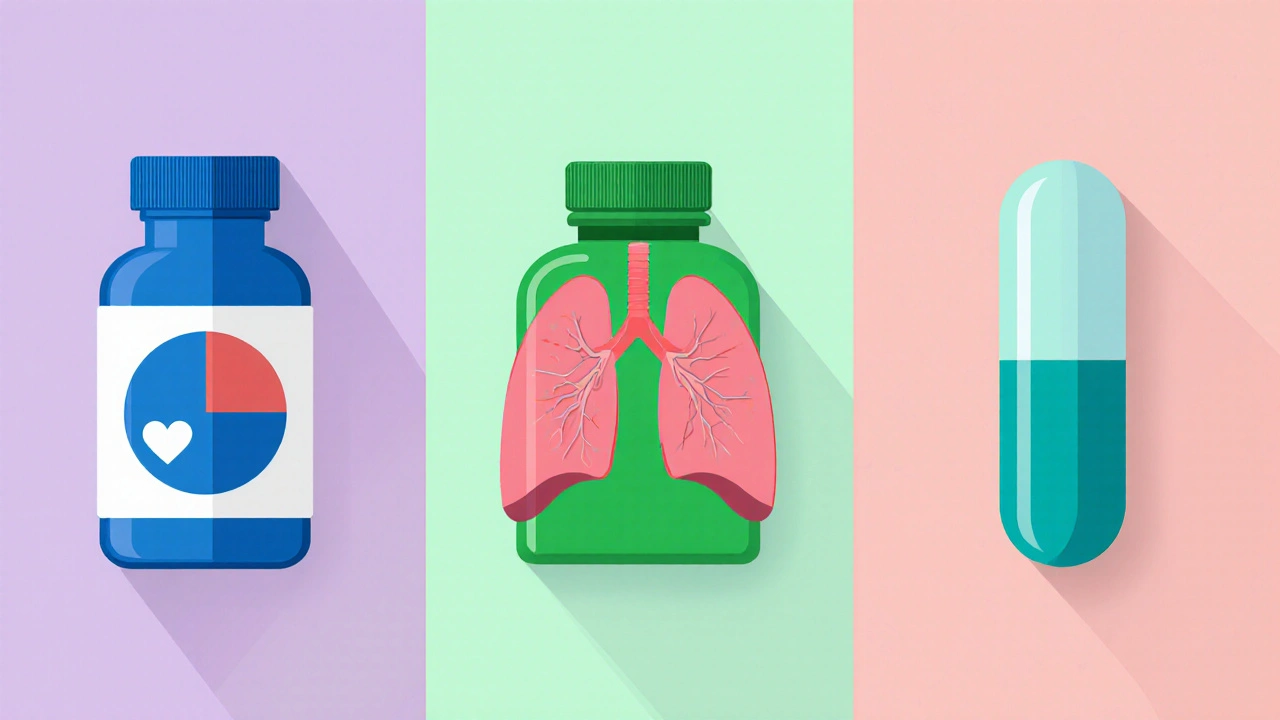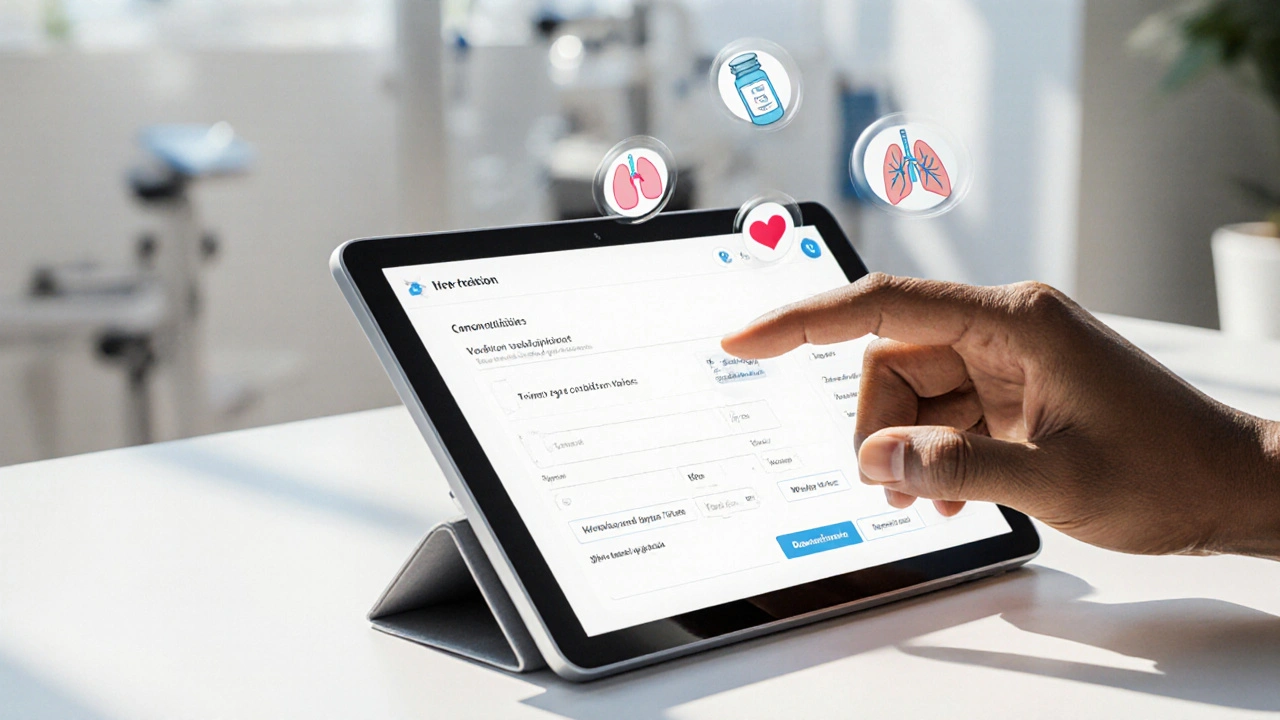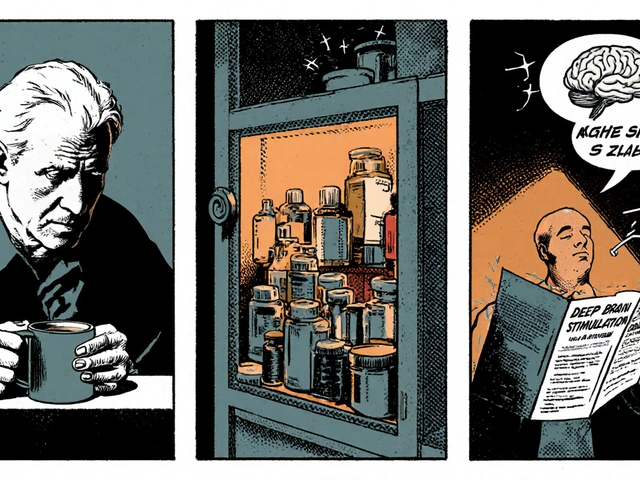Beta-Blocker Alternative Selector
Recommended Medication
Select your conditions and click "Find Best Medication Option" to see personalized recommendations.
When it comes to controlling heart rate, Propranolol is a non‑selective beta‑adrenergic blocker that blocks both β1 and β2 receptors. It’s been a household name for decades, but you’re probably wondering how it stacks up against the newer options on the market. This guide walks through the most common alternatives, breaks down efficacy, side‑effects, and dosing, and helps you decide which drug fits your health goals best.
Key Takeaways
- Propranolol works for hypertension, angina, arrhythmias, migraine prevention, and performance anxiety.
- Selective beta‑blockers like atenolol and metoprolol cause fewer respiratory issues but may be less effective for tremor control.
- Non‑beta‑blocker drugs such as lisinopril or amlodipine are first‑line for high blood pressure when beta‑blockers aren’t tolerated.
- Side‑effect profiles differ: propranolol can trigger bronchospasm, while carvedilol adds alpha‑blocking benefits.
- Choosing the right medication depends on your primary condition, comorbidities, and lifestyle.
What Is Propranolol?
First approved in the 1960s, propranolol belongs to the beta‑blocker class. Its non‑selective action means it blocks both cardiac β1 receptors (slow heart rate) and lung β2 receptors (relax airway muscles). The result is lower heart rate, reduced contractility, and decreased blood pressure.
How Propranolol Works
The drug competes with adrenaline for beta‑adrenergic sites. By blunting the sympathetic “fight‑or‑flight” signal, propranolol dampens the surge in heart rate that occurs during stress or exercise. This makes it useful not only for heart disease but also for anxiety‑related tremors and migraine prophylaxis.
Main Clinical Uses
- Essential hypertension - especially when other agents fail.
- Angina pectoris - reduces myocardial oxygen demand.
- Ventricular arrhythmias - stabilizes electrical activity.
- Migraine prevention - lowers frequency of attacks.
- Performance anxiety - calms physical symptoms like shaking.
Comparison Criteria
When looking at alternatives, keep these five factors in mind:
- Selectivity: Does the drug target β1 only (cardio‑selective) or both β1/β2?
- Half‑life & dosing frequency: Longer half‑life means once‑daily dosing.
- Side‑effect burden: Respiratory, metabolic, or CNS effects.
- Comorbid suitability: Diabetes, asthma, or depression considerations.
- Evidence for specific indications: Migraine, anxiety, or heart failure benefits.

Beta‑Blocker Alternatives
Below are the most frequently prescribed alternatives, each introduced with a brief definition.
Atenolol is a cardio‑selective beta‑blocker that primarily blocks β1 receptors, making it gentler on the lungs.
Metoprolol is another β1‑selective blocker, available in immediate‑release and extended‑release formulations for flexible dosing.
Carvedilol combines non‑selective β‑blockade with α1‑blockade, offering added vasodilation useful in heart‑failure patients.
Nebivolol is a third‑generation β1‑selective blocker that releases nitric oxide, improving endothelial function.
Non‑Beta‑Blocker Alternatives
For those who can’t tolerate beta‑blockers, several other drug classes are first‑line for blood‑pressure control or anxiety.
Lisinopril is an ACE inhibitor that relaxes blood vessels by blocking the conversion of angiotensin I to angiotensin II.
Amlodipine is a calcium‑channel blocker that dilates arterial smooth muscle, reducing systolic pressure.
Sertraline (an SSRI) is commonly used for generalized anxiety disorder and can be an alternative when the primary issue is anxiety rather than cardiovascular disease.
Side‑Effect Profile Comparison
| Drug | Class | Typical Side‑Effects | Key Contra‑indications |
|---|---|---|---|
| Propranolol | Non‑selective β‑blocker | Bronchospasm, fatigue, cold extremities, depression | Asthma, severe bradycardia, uncontrolled heart failure |
| Atenolol | Selective β1‑blocker | Fatigue, dizziness, sexual dysfunction | Severe hepatic impairment, AV block |
| Metoprolol | Selective β1‑blocker | Bradycardia, depression, sleep disturbances | Asthma (high dose), cardiogenic shock |
| Carvedilol | Non‑selective β + α1 blocker | Orthostatic hypotension, weight gain, dizziness | Severe liver disease, bronchospasm |
| Lisinopril | ACE inhibitor | Cough, hyperkalemia, angioedema | History of angioedema, pregnancy |
| Amlodipine | Calcium‑channel blocker | Peripheral edema, gingival hyperplasia, headache | Severe aortic stenosis, hypotension |
| Sertraline | SSRI antidepressant | Nausea, sexual dysfunction, insomnia | MAOI use within 14 days, severe liver disease |
Choosing the Right Drug for You
Use the following decision flow to narrow down the best option:
- If your primary issue is high blood pressure and you have no lung disease, start with an ACE inhibitor like Lisinopril - it has a low side‑effect burden.
- If you need heart‑rate control (e.g., arrhythmia) and can tolerate beta‑blockers, choose a cardio‑selective agent such as Metoprolol for fewer respiratory complaints.
- When anxiety or tremor is the main complaint, non‑selective propranolol remains a cost‑effective choice, but only if you don’t have asthma.
- For patients with both heart failure and hypertension, Carvedilol offers the added benefit of vasodilation.
- If you have diabetes with peripheral neuropathy, a β‑blocker that doesn’t mask hypoglycemia signs (e.g., Nebivolol) may be preferable.
Practical Checklist Before Starting Therapy
- Review your medical history for asthma, chronic obstructive pulmonary disease, or severe bradycardia.
- List current medications - watch for interactions with calcium‑channel blockers or ACE inhibitors.
- Know your target condition: blood pressure, angina, arrhythmia, migraine, or anxiety.
- Discuss potential side‑effects you’re most concerned about; this guides the selectivity choice.
- Schedule baseline labs (renal function, electrolytes) especially if starting ACE inhibitors or diuretics.
Frequently Asked Questions
Can I switch from propranolol to a selective beta‑blocker without a doctor’s supervision?
Never. Abruptly stopping propranolol can cause rebound hypertension or tachycardia. A physician should taper the dose and overlap the new agent as needed.
Is propranolol effective for migraine prevention?
Yes. Clinical trials show a 40‑50% reduction in migraine days when propranolol is taken daily at 80‑160mg. It works by stabilizing vascular tone.
What’s the biggest advantage of carvedilol over propranolol?
Carvedilol’s α1‑blocking activity adds vasodilation, which reduces afterload in heart‑failure patients - a benefit propranolol lacks.
Are there any natural alternatives for performance anxiety?
Mind‑body techniques (deep breathing, progressive muscle relaxation) work well. Some people try magnesium or L‑theanine, but evidence is limited compared with propranolol’s proven effect.
How often should I have my blood pressure checked after starting a new antihypertensive?
Check daily for the first two weeks, then weekly until stable, and finally at each primary‑care visit (usually every 3‑6 months).

Next Steps
If you’ve identified a candidate drug, schedule a consultation with your prescriber. Bring this checklist, your current medication list, and any recent lab results. Ask about tapering schedules if you’re switching from propranolol, and clarify how long you’ll need to wait before assessing effectiveness (typically 4‑6 weeks for blood‑pressure goals).
Remember, no single medication fits everyone. By weighing selectivity, dosing convenience, side‑effect risk, and your personal health picture, you can land on the option that keeps you feeling steady and safe.







stephen henson
3 October 2025 - 02:40 AM
Great rundown of the beta‑blocker landscape! 👍 I especially appreciate how you broke down when a non‑selective option like propranolol makes sense versus a cardio‑selective pick. If you have any lung concerns, the cardio‑selective agents are usually safer, and for migraine prevention propranolol still shines. Keep in mind the dosing flexibility-once‑daily formulations can really help adherence. Good luck finding the right match! 😊
Manno Colburn
8 October 2025 - 09:52 AM
When you stare at a table of beta‑blockers, you can’t help but feel like you’re peering into the very soul of modern pharmacology.
The truth, as I see it, is that every molecule is a tiny political statement, a rebellion against the chaos of our sympathetic nervous system.
Propranolol, with its old‑school non‑selectivity, screams defiant robustness, refusing to bow to the newest selective whisperers.
Yet the newer agents, such as atenolol or nebivolol, claim a more enlightened existence, promising fewer side‑effects while still holding the reins on heart rate.
It is a paradox that the more refined the drug, the more it tries to hide its influence, like a magician’s sleight of hand.
Consider the half‑life: propranolol darts through the bloodstream and disappears within hours, demanding multiple doses, while carvedilol lingers like a lazy Sunday afternoon.
And then there’s the myth of “beta‑blockers mask hypoglycemia” – a rumor that has been repeated so often that it feels like a cultural meme rather than a physiological fact.
If you ask yourself why asthma patients are warned, you’ll find the answer in the very nature of beta‑2 blockade, a simple mechanical obstruction of airway dilation.
But why do we cling to that warning when the data shows that cardio‑selective agents can be used with caution, a compromise that many clinicians accept?
The industry’s marketing machine loves to paint propranolol as a one‑size‑fits‑all hero, while quietly nudging patients toward the newer, more profitable brands.
This dance of profit and prescription is not new; it dates back to the first synthesized drug in the mid‑twentieth century.
Thus, the choice between propranolol and its alternatives is not just a medical decision, it is a reflection of our willingness to trust tradition over novelty.
In the end, the heart will beat regardless of which pill you swallow, but the side‑effects, the cost, and the philosophical comfort differ.
So, dear reader, weigh the bronchospasm risk like you would weigh a bridge’s load before stepping onto it.
Do not be fooled by a glossy pill bottle that promises no tremor while hiding a cough in the fine print.
Remember, each option carries its own story, and the story you choose to live is the one you will tell your doctor tomorrow.
Namrata Thakur
13 October 2025 - 17:21 PM
This guide really helps untangle the maze of options. Propranolol works well for migraines and anxiety, but you have to watch out for breathing issues. If you have asthma, a cardio‑selective blocker like metoprolol is usually a safer bet. For high blood pressure without lung problems, ACE inhibitors such as lisinopril are often first‑line and easier on the body. Remember to check your labs before starting a new drug, especially kidney function for ACE inhibitors. Overall, match the drug to your main condition and any other health concerns you have.
Chloe Ingham
5 December 2025 - 16:21 PM
All this talk about “alternatives” feels like a smokescreen. Have you ever considered that big pharma pushes the newest brand‑names to keep us dependent? The subtle side‑effects they hide in the fine print are the real experiment. Even the “safe” cardio‑selective blockers have hidden pathways that could be used to manipulate heart rhythm. It’s a reminder that we should stay skeptical of any blanket recommendation.